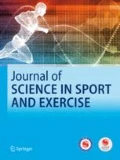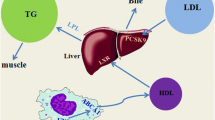Abstract
Introduction
To study the effects of aerobic exercise on lipid metabolism, endothelial function, and oxidative stress reaction in postmenopausal women, in order to prevent and control atherosclerosis.
Methods
Thirty-two women with natural menopause were randomly divided into an exercise group and a control group. Participants in the exercise group (n = 16) took part in a 3-month aerobic training program according to their exercise prescription, while participants in the control group (n = 16) maintained their usual lifestyles. Lipids, endothelial function, and oxidative stress-related indicators were measured before and after the intervention.
Results
After 3 months of aerobic training at an intensity of 50–60% of cardiorespiratory fitness, serum total cholesterol and low-density lipoprotein cholesterol decreased significantly (P < 0.05), and high-density lipoprotein cholesterol increased significantly (P < 0.01). A significant reduction in endothelin (P < 0.01) and a significant increase in nitric oxide (P < 0.05) were also observed. The training intervention also delayed the increase in homocysteine and cysteine aspartate-specific protease-3 in postmenopausal women.
Conclusions
Aerobic exercise had a positive effect on blood lipids, endothelial function, and oxidative stress of postmenopausal women, and these changes may mitigate the risk of atherosclerosis occurrence. Similar exercise programs could be used as a primary atherosclerosis prevention strategy for postmenopausal women.






Similar content being viewed by others
References
American College of Sports Medicine. ACSM’s Guidelines for exercise testing and prescription. 9th ed. Philadelphia: Lippincott Williams & Wilkins; 2014. p. 173.
Bailey S, Gloeckner A, Kreutzer A, Garrity E, Adams LC, Cook C, Mitchell JB, Cheek DJ, Oliver J, Phillips MD, Shah M. Effect of prior aerobic exercise on high-sugar meal induced endothelial dysfunction in postmenopausal women. Int J Exerc Sci. 2018;2(10):76–80.
Baszczuk A, Kopcztnski Z. Endothelial dysfunction in patients with primary hypertension and hyperhomocysteinemia. Postepy higieny i medycyny doswiadczalnej. 2014;68:91–100.
Battault S, Singh F, Gayrard S, Zoll J, Reboul C, Meyer G. Endothelial function does not improve with high-intensity continuous exercise training in SHR: implications of eNOS uncoupling. Hypertens Res. 2015;289(6453):1229.
Cersosimo E, Defronzo RA. Insulin resistance and endothelial dysfunction: the road map to cardiovascular diseases. Diabetes Metab Res Rev. 2006;22(6):423–36.
Dallck LC, Allen BA, Hanson BA, Borresen EC, Erickson ME, De Lap SL. Dose-response relationship between moderate-intensity exercise duration and coronary heart disease risk factors in postmenopausal women. J Womens Health. 2009;18(1):105–13.
Edwards N, Langford-Smith AWW, Wilkinson FL, Alexander MY. Endothelial progenitor cells: new targets for therapeutics for inflammatory conditions with high cardiovascular risk. Front Med. 2018;200(5):1–11.
Eliasson B, Gudbjörnsdottir S, Zethelius B, Eeg-Olofsson K, Cederholm J. LDL-cholesterol versus non-HDL-to-HDL-cholesterol ratio and risk for coronary heart disease in type 2 diabetes. Eur J Prev Cardiol. 2014;21(11):1420–8.
Far SN, Taherichadorneshin H. Aerobic exercise training reduces inflammatory markers involved in atherosclerosis. J Basic Res Med Sci. 2018;5(1):29–37.
Fenster CP, Weinsier RL, Darley-Usmar VM, Patel RP. Obesity, aerobic exercise, and vascular disease: the role of oxidant stress. Obes Res. 2002;10(9):964–8.
Filip M, Maciag J, Nosalski R, Korbut R, Guzik T. Endothelial dysfunction related to oxidative stress and inflammation in perivascular adipose tissue. Postepy Biochem. 2012;58(2):186–94.
Gordon DJ, Probstfield JL, Garrison RJ, Neaton JD, Castelli WP, Knoke JD, Jacobs DR Jr, Bangdiwala S, Tyroler HA. High-density lipoprotein cholesterol and cardiovascular disease. Four prospective American studies. Circulation. 1989;79(1):8–15.
Grootaert MOJ, Schrijvers DM, Marthe H, von Harsdorf R, De Meyer GR, Martinet W. Caspase-3 deletion promotes necrosis in atherosclerotic plaques of apoE knockout mice. Oxidative Med Cell Longev. 2016;2016:1–11.
Grundy SM, Bilheimer D, Chait A, Clark LT, Denke M, Havel RJ, Hazzard WR, Hulley SB, Hunninghake DB, Kreisberg RA, KrisEtherton P, McKenney JM, Newman MA, Schaefer EJ, Sobel BE, Somelofski C, Weinstein MC, Brewer HB Jr, Cleeman JI, Donato KA, Ernst N, Hoeg JM, Basil M, Rifkind BM, Rossouw J, Sempos CT, Gallivan JM, Harris MN, Quint-Adler L. Summary of the second report of the National Cholesterol Education Program (NCEP) expert panel on detection, evaluation, and treatment of high blood cholesterol in adults (Adult Treatment Panel II). JAMA. 1993;269(23):3015–23.
Hildreth KL, Kohrt WM, Moreau KL. Oxidative stress contributes to large elastic arterial stiffening across the stages of the menopausal transition. Menopause. 2014;21(6):624–32.
Kanani PM, Sinkey CA, Browing RL, Allaman M, Knapp HR, Haynes WG. Role of oxidant stress in endothelial dysfunction produced by experimental hyperhomocysteinemia in humans. Circulation. 1999;100(11):1161–8.
Lammert A, Hasenberg T, Imhof I, Schnülle P, Benck U, Krämer BK, Hammes HP. High prevalence of retinal endothelial dysfunction in obesity WHO class III. Microvasc Res. 2012;84(3):362–6.
LaRosa JC, Hunninghake D, Bush D, Criqui MH, Getz GS, Gotto AM Jr, Grundy SM, Rakita L, Robertson RM, Weisfeldt ML. The cholesterol facts. A summary of the evidence relating dietary fats, serum cholesterol, and coronary heart disease. Circulation. 1990;81(5):1721–33.
Leening MJ, Ferket BS, Steyerberg EW, Kavousi M, Deckers JW, Nieboer D, Heeringa J, Portegies ML, Hofman A, Ikram MA, Hunink MG, Franco OH, Stricker BH, Witteman JC, Roos-Hesselink JW. Sex differences in lifetime risk and first manifestation of cardiovascular disease: prospective population based cohort study. BMJ. 2014;349:g5992.
Li J, Li PF, Dietz R, von Harsdorf R. Intracellular superoxide induces apoptosis in VSMCs: role of mitochondrial membrane potential, cytochrome C and caspase. Apoptosis. 2002;7(6):511–7.
Maeda S, Miyauchi T, Kakiyama T, Sugawara J, Iemitsu M, Irukayama-Tomobe Y, Murakami H, Kumagai Y, Kuno S, Matsuda M. Effects of exercise training of 8 weeks and det raining on plasma levels of endothelium-derived factors, endothelin-1 and nitric oxide, in healthy young humans. Life Sci. 2001;69(9):1005–16.
Matulevicius S, Rohatgi A, Khera A, Das SR, Owens A, Ayers CR, Timaran CH, Rosero EB, Drazner MH, Peshock RM, de Lemos JA. The association between plasma caspase-3, atherosclerosis, and vascular function in the Dallas Heart Study. Apoptosis. 2008;13(10):1281–9.
Miller M, Stone NJ, Ballantyne C, Bittner V, Criqui MH, Ginsberg HN, Goldberg AC, Howard WJ, Jacobson MS, Kris-Etherton PM, Lennie TA, Levi M, Mazzone T, Pennathur S. Triglycerides and cardiovascular disease: a scientific statement from the American Heart Association. Circulation. 2011;123(20):2292–333.
Miyaki A, Maeda S, Yoshizawa M, Misono M, Saito Y, Sasai H, Endo T, Nakata Y, Tanaka K, Ajisaka R. Effect of weight reduction with dietary intervention on arterial distensibility and endothelial function in obese men. Angiology. 2009;60(3):351–7.
Miyashita M, Edamoto K, Kidokoro T, Yanaoka T, Kashiwabara K, Takahashi M, Burns S. Interrupting sitting time with regular walks attenuates postprandial triglycerides. Int J Sports Med. 2016;37(2):97–103.
Moreau KL, Gavin KM, Plum AE, Seals DR. Ascorbic acid selectively improves large elastic artery compliance in postmenopausal women. Hypertension. 2005;45(6):1107–12.
Moreau KL, Hildreth KL, Meditz AL, Deane KD, Kohrt WM. Endothelial function is impaired across the stages of the menopause transition in healthy women. J Clin Endocrinol Metab. 2012;97(12):4692–700.
Mury P, Chirico EN, Mura M, Millon A, Canet-Soulas E, Pialoux V. Oxidative stress and inflammation, key targets of atherosclerotic plaque progression and vulnerability: potential impact of physical activity. Sports Med. 2018;48(12):2725–41.
Nepal S, Malik S, Sharma AK, Bharti S, Kumar N, Siddiqui KM, Bhatia J, Kumari S, Arya DS. Abresham ameliorates dyslipidemia, hepatic steatosis and hypertension in high-fat diet fed rats by repressing oxidative stress, TNF-α and normalizing NO production. Exp Toxicol Pathol. 2012;64(7–8):705–12.
Ptak A, Rak-Mardyla A, Gregoraszczuk EL. Cooperation of bisphenol A and leptin in inhibition of caspase-3 expression and activity in OVCAR-3 ovarian cancer cells. Toxicol In Vitro. 2013;27(6):1937–43.
Rauramaa R, Hassinen M. Exercise training and endothelial function. Curr Cardiovasc Risk Rep. 2011;5(4):323–30.
Ray KK, Cannon CP, Cairns R, Morrow DA, Ridker PM, Braunwald E. Prognostic utility of apoB/AI, total cholesterol/HDL, non-HDL cholesterol, or hs-CRP as predictors of clinical risk in patients receiving statin therapy after acute coronary syndromes results from PROVE IT-TIMI 22. Arterioscler Thromb Vasc Biol. 2009;29(3):424–30.
Rossi R, Nuzzo A, Origliani G, Modena MG. Prognostic role of flow-mediated dilation and cardiac risk factors in post-menopausal women. J Am Coll Cardiol. 2008;51(10):997–1002.
Saito T, Hayashi K, Nakazawa H, Ota T. Clinical characteristics and lesions responsible for swallowing hesitation after acute cerebral infarction. Dysphagia. 2016;31(4):567–73.
Santos-Parker JR, Strahler TR, Vorwald VM, Pierce GL, Seals DR. Habitual aerobic exercise does not protect against micro- or macrovascular endothelial dysfunction in healthy estrogen-deficient postmenopausal women. J Appl Physiol. 2017;122(1):11–9.
Serviente C, Troy LM, de Jonge M, Shill DD, Jenkins NT, Witkowski S. Endothelial and inflammatory responses to acute exercise in perimenopausal and late postmenopausal women. Am J Physiol Regul Integr Comp Physiol. 2016;311(5):R841–50.
Signorelli SS, Neri S, Sciacchitano S, Pino LD, Costa MP, Marchese G, Celotta G, Cassibba N, Pennisi G, Caschetto S. Behaviour of some indicators of oxidative stress in postmenopausal and fertile women. Maturitas. 2006;53(1):77–82.
Spence JD, Hachinski V. B vitamins for stroke prevention: interaction of low platelet count and high plasma total homocysteine. J Am Coll Cardiol. 2018;71(19):2147–8.
Sreckovic B, Sreckovic VD, Soldatovic I, Colak E, Sumarac-Dumanovic M, Janeski H, Janeski N, Gacic J, Mrdovic I. Homocysteine is a marker for metabolic syndrome and atherosclerosis. Diabetes Metab Syndr. 2017;9(3):179–82.
Taleb-Belkadi O, Chaib H, Zemour L, Fatah A, Chafi B, Mekki K. Lipid profile, inflammation, and oxidative status in peri- and postmenopausal women. Gynecol Endocrinol. 2016;32(12):982–5.
The Lipid Research Clinics Program. The lipid research clinics coronary primary prevention trial results. I. Reduction in incidence of coronary heart disease. JAMA. 1984;251(3):351–64.
Van Guilder GP, Stauffer BL, Greiner JJ, Desouza CA. Impaired endothelium-dependent vasodilation in overweight and obese adult humans is not limited to muscarinic receptor agonists. Am J Physiol Heart Circ Physiol. 2008;294(4):1685–92.
Villablanca AC, Jayachandran M, Banka C. Atherosclerosis and sex hormones: current concepts. Clin Sci. 2010;119(12):493–513.
Wang Y, Ren A, Weng X, Zhang S. Influence of exercise intervention on peroxidation and vascular endothelial function for experimental hyperhomocysteinemia rats. Chin J Rehabil Med. 2016;31(11):1208–12.
Witkowski S, Serviente C. Endothelial dysfunction and menopause: is exercise an effective countermeasure? Climacteric. 2018;21(3):267–75.
Wong A, Sanchez-Gonzalez MA, Son WM, Kwak YS, Park SY. The effects of a 12-week combined exercise training program on arterial stiffness, vasoactive substances, inflammatory markers, metabolic profile, and body composition in obese adolescent girls. Pediatr Exerc Sci. 2018;30(4):480–6.
Yalamudi K. Study of comparison between autonomic dysfunction and dyslipidemia in healthy postmenopausal women. Int J Adv Res. 2017;5(7):968–80.
Yusuf S, Hawken S. Effect of potentially modifiable risk factors associated with myocardial in 52 countries: case–control study. Lancet. 2004;364(9438):937–52.
Zhao D, Liu J, Xie W, Qi Y. Cardiovascular risk assessment: a global perspective. Nat Rev Cardiol. 2015;12(5):301–11.
Acknowledgements
This work was supported by the General Administration of Sport of China (2017B064) and Beijing Sport University (2018GJ014). The authors sincerely thank all of the women who participated in the study and Gaye Groover Christmus, MPH for editorial assistance in the development of the manuscript.
Author information
Authors and Affiliations
Corresponding author
Ethics declarations
Conflicts of interest
The authors declare no conflicts of interest.
Rights and permissions
About this article
Cite this article
Luo, M., Zhang, P., Zhou, X. et al. Effects of Aerobic Exercise on Atherosclerotic Risk in Postmenopausal Women. J. of SCI. IN SPORT AND EXERCISE 1, 132–141 (2019). https://doi.org/10.1007/s42978-019-0024-5
Received:
Accepted:
Published:
Issue Date:
DOI: https://doi.org/10.1007/s42978-019-0024-5




